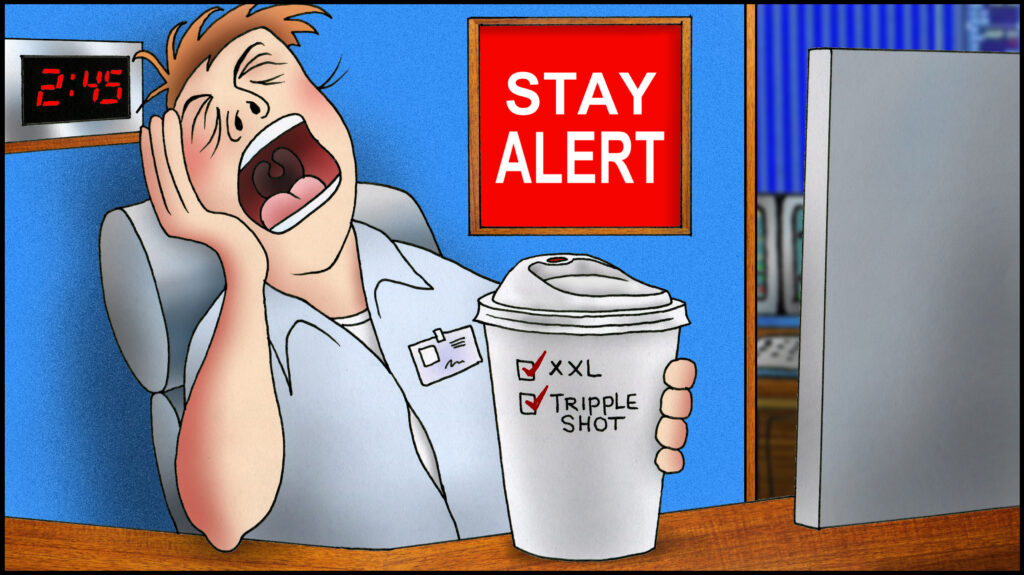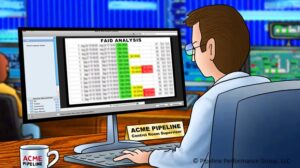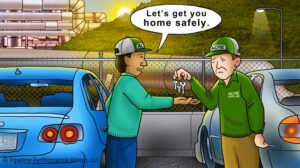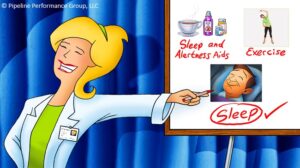Joe has just completed the shift turnover and is finally ready to leave after his rotation on night shift. Due to a possible leak on the pipeline, this last shift included a couple of hectic hours on duty and an increased number of calls and questions. Even though it turned out to be a false alarm, the stress of the entire week has left him feeling more weary than usual. To complicate matters, Joe’s young son has been sick with a cough and fever the last few days so no one in the family has been sleeping well. At the moment, all he can think about is getting home and collapsing into bed.
The drive home is particularly challenging for Joe. The sky is still dark and the oncoming headlights are painfully bright for his tired eyes. “Maybe if I close them for a few seconds at the traffic light…,” he thinks. But this only makes his brain desire sleep more. “Micro-sleeps,” he remembers, “I saw a video on how dangerous those are. I can’t let that happened to me.” He rolls down the window to feel the rush of cold air but still finds himself struggling to stay awake for the 40-minute drive home. His judgment for distance is off. He crosses the solid line then jerks the car back into his lane. He feels his brain struggling to stay alert.
Have you felt this kind of extreme fatigue? Law enforcement might suspect this driver is intoxicated. In fact, there is no chemical test to identify the presence of fatigue as there is for identifying the presence of drugs and alcohol. Because a researcher, Dr. Drew Dawson, suspected there was a similarity in the way fatigue and alcohol affect our bodies, he conducted a study using two separate groups of people. His goal was to compare human performance under the influence of alcohol and under the influence of fatigue. He found that both groups, the intoxicated group and the fatigued group, scored similarly on alertness and vigilance tests. Have you ever endured a workday or a drive home while under the influence of fatigue?
There are simple tools you can use to recognize signs of fatigue in order to take corrective action and avoid the danger of making careless mistakes or having an accident. Consider how many hours you have slept in the past twenty-four hours and in the past week. Avoid sleep debt.
The Stanford Sleepiness Scalei is a simple tool, useful for assessing your own alertness throughout the day using a seven-point scale ranging from complete alertness (1) to barely awake (7).
| Degree of Sleepiness | Rating |
| Feeling active, vital, alert, or wide awake | 1 |
| Functioning at high levels, but not fully alert | 2 |
| Awake, but relaxed, responsive but not fully alert | 3 |
| Somewhat foggy, let down | 4 |
| Foggy, losing interest in remaining awake, slowed down | 5 |
| Sleepy, woozy, fighting sleep, prefer to lie down | 6 |
| No longer fighting sleep, sleep onset soon, having dream-like thoughts | 7 |
| Asleep | X |
If you find that you’re beginning to feel drowsy and sluggish (rating 4), that’s a sign you should take a break from the console. Do an Alertness Exercise, take a walk or get a snack. Rating 4 or higher indicate you could be suffering from a lack of sleep. Don’t allow sleep deprivation to impair your health, physical safety, or job safety.
MANAGING FATIGUE EDUCATIONAL PROGRAM | Scarlet Knight © 2021 Please Distribute to Others.




